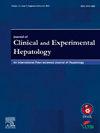Impact of Perioperative Serum Sodium Levels on Outcomes Following Living Donor Liver Transplantation
IF 3.3
Q2 GASTROENTEROLOGY & HEPATOLOGY
Journal of Clinical and Experimental Hepatology
Pub Date : 2025-02-03
DOI:10.1016/j.jceh.2025.102511
引用次数: 0
Abstract
Background & objectives
Preoperative hyponatremia has been shown to be associated with poor outcomes post-liver transplantation. We analyzed the impact of preoperative hyponatremia and perioperative sodium (Na) changes on outcomes following adult living donor liver transplantation.
Methods
After obtaining clearance from Institutional ethical Committee, a retrospective review of electronic database and medical records of all adult patients who underwent LDLT between January 2019 and September 2022 was done and relevant perioperative data were collected.
Results
The study cohort of 520 recipients was divided into four groups based on preoperative serum Na levels in mmol/L; 12 patients (2.3%) in Group A (<125); 66 patients (12.6%) in Group B (125–129); 216 patients (41.5%) in Group C (130–135) and 226 patients (43.4%) in Group D (136–145). MELD score, preoperative AKI, SBP, intraoperative ascites volume, volume of packed blood cells (PRC), other blood products and 25% albumin were significantly associated with the degree of hyponatremia. No other outcomes including mortality was associated any grade of hyponatremia. The delta sodium on postoperative day 1 was largest in Group A. The level of Na rise post-transplant on POD1 had an inverse correlation with preoperative Na levels [ r (520) −0.6, P < 0.001]. High delta sodium was not associated with neurological complications in this cohort. Group A patients had higher incidence of postoperative AKI requiring dialysis followed by groups B, C and D. Eighty-six (16.5%) patients had large delta-Na of >10 mmol/L. On univariate analysis, low pretransplant Na (<130mEq/L), preoperative AKI, SBP, higher MELD and ascitic volumes, intraoperative transfusions of PRC, blood products and 25% albumin, early allograft dysfunction and need for dialysis, were associated with larger delta-Na. On multivariate analysis, preoperative Na levels ≤130 mmol/L, intraoperative ascites and PRC transfusion were found to be independent risk factors for a large delta-Na.
Conclusion
Hyponatremia, being a factor associated with liver disease, might not by itself contribute to poor survival when the deleterious effects of large delta changes can be avoided. The results from this study reinforces the fact that with a cautious perioperative approach, patients with hyponatremia can be transplanted safely in LDLT settings.

围手术期血清钠水平对活体肝移植术后预后的影响
背景,目的术前低钠血症已被证明与肝移植后不良预后相关。我们分析了术前低钠血症和围手术期钠(Na)变化对成人活体肝移植术后预后的影响。方法在获得机构伦理委员会批准后,对2019年1月至2022年9月期间接受LDLT治疗的所有成年患者的电子数据库和病历进行回顾性分析,并收集相关围手术期数据。结果根据术前血清钠水平(mmol/L)将520例受体患者分为4组;A组12例(2.3%)(125例);B组66例(12.6%)(125 ~ 129);C组(130 ~ 135)216例(41.5%),D组(136 ~ 145)226例(43.4%)。MELD评分、术前AKI、收缩压、术中腹水体积、堆积血细胞体积(PRC)、其他血液制品和25%白蛋白与低钠血症程度显著相关。包括死亡率在内的其他结果与低钠血症的任何程度无关。a组术后第1天的δ钠含量最高,移植后POD1的Na升高水平与术前Na水平呈负相关[r(520)−0.6,P <;0.001]。在这个队列中,高钠与神经系统并发症无关。A组患者术后需要透析的AKI发生率较高,其次为B、C、d组。86例(16.5%)患者δ na大,达10 mmol/L。在单因素分析中,低移植前Na (130mEq/L)、术前AKI、收缩压、较高MELD和腹水容量、术中输注PRC、血液制品和25%白蛋白、早期同种异体移植物功能障碍和透析需求与较大的δ Na相关。多因素分析发现术前钠水平≤130 mmol/L、术中腹水和输血是大δ Na的独立危险因素。结论低钠血症是肝脏疾病的一个相关因素,如果可以避免大δ变化的有害影响,低钠血症本身可能不是导致生存差的因素。这项研究的结果强化了这样一个事实,即通过谨慎的围手术期方法,低钠血症患者可以安全地在LDLT环境中进行移植。
本文章由计算机程序翻译,如有差异,请以英文原文为准。
求助全文
约1分钟内获得全文
求助全文
来源期刊

Journal of Clinical and Experimental Hepatology
GASTROENTEROLOGY & HEPATOLOGY-
CiteScore
4.90
自引率
16.70%
发文量
537
审稿时长
64 days
 求助内容:
求助内容: 应助结果提醒方式:
应助结果提醒方式:


